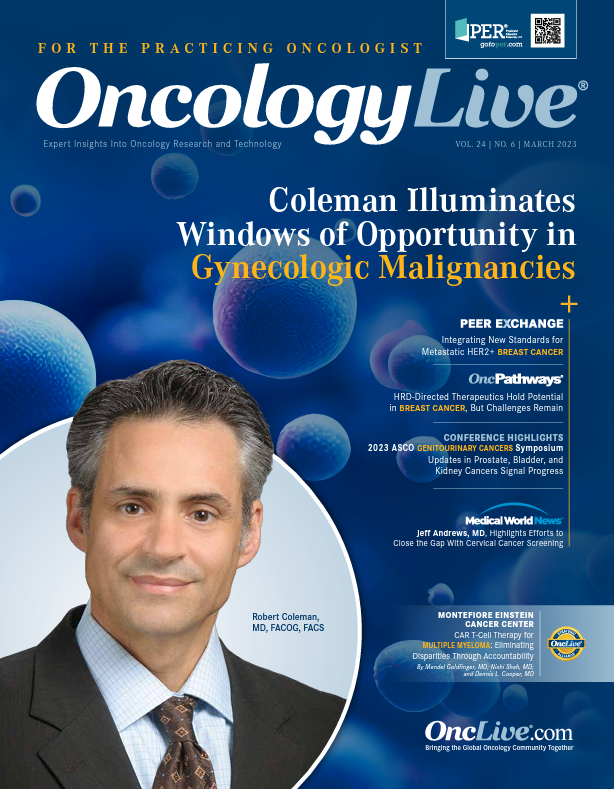Publication
Article
CAR T-Cell Therapy for Multiple Myeloma: Eliminating Disparities Through Accountability
Author(s):
Although the first FDA approval for CAR T-cell therapy in multiple myeloma was 2 years ago, unfortunately, the treatment remains out of reach for too many patients.
Mendel Goldfinger, MD

Chimeric antigen receptors (CAR) T cells represent a practice-changing therapy for patients with multiple myeloma who have triple-class refractory (immunomodulatory drug, proteasome, and anti-CD38) disease. When conventional therapy is used for patients with this condition, response rates are approximately 30% and survival is relatively short at only 1 year.1 In contrast, the first CAR T product to reach the market for myeloma, idecabtagene vicleucel (Abecma; ide-cel), manufactured by Bristol Myers Squibb (BMS), resulted in an 80% response rate at the approved cell dose with overall survival of 19 months.2 The second CAR T product, ciltacabtagene autoleucel (Carvykti; cilta-cel), manufactured by Janssen, showed a 98% response rate with approximately 60% of patients free of disease progression at 2 years.3
What makes these statistics even more remarkable is that despite being heavily pretreated with a median of 6 lines of prior therapy, patients treated with cilta-cel achieved a higher complete response rate than those who just received a diagnosis and were treated sequentially with a 4-drug induction therapy, autologous transplant, and consolidation,4 clearly establishing cilta-cel as the single most effective treatment for patients with multiple myeloma.
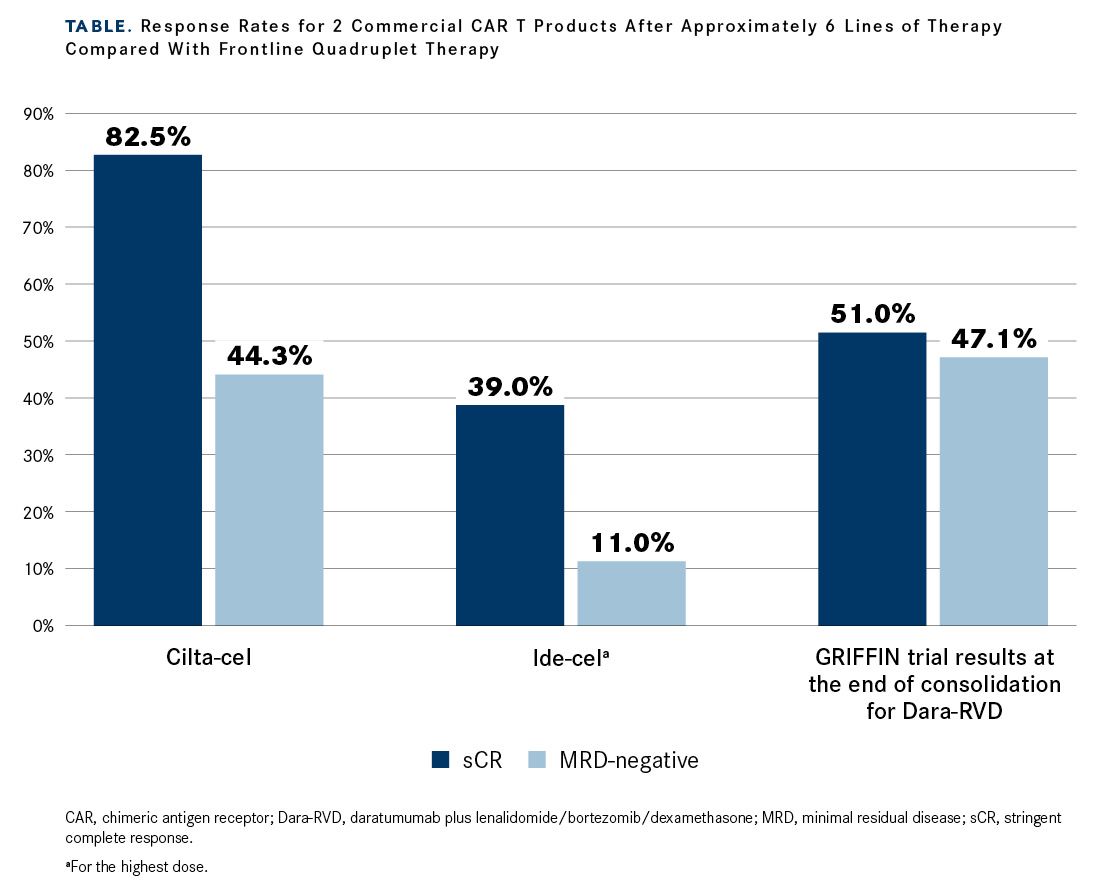
Significantly, the one-and-done schedule of CAR T products also gives patients an extended drug holiday. This break is the first for many since initially receiving a cancer diagnosis.
Although the first FDA approval for CAR T-cell therapy in multiple myeloma was 2 years ago, unfortunately, the treatment remains out of reach for too many patients. In one study, the cumulative incidence of receiving ide-cel was 18% at 6 months, and only 40% of patients received the therapy at 12 months compared with 1 in 4 patients dying while waiting for CAR T.5 In a second study, 17 high-volume centers in the United States experienced challenges with patient selection criteria, allocation of CAR T products, and wait times. At the time of this survey, a median of 1 slot per month was allocated per center, the average waiting list was 20 patients per month, and patients had to wait approximately 6 months before cell collection. The percentage of patients that received CAR T-cell therapy was similar (25%) to the number of patients who died waiting for treatment.6
Nishi Shah, MD
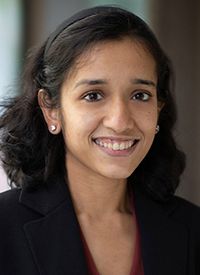
Both studies likely underestimate the number of individuals who could have benefited from treatment. In part, this is because many patients in the United States do not have access to a treatment center where they could be placed on a waiting list. And, as has been seen with so many other medical-related issues, groups that have been economically and socially marginalized continue to be disproportionately affected.
For example, a recent study showed that only 36% of Black patients live in a county with an open CAR T clinical trial.7 Further, in Mississippi and Louisiana, 2 states with the highest population of Black individuals—a group that is twice as likely to die from multiple myeloma compared with White patients—there are no centers that administer ide-cel or cilta-cel. For a patient living in New Orleans, Louisiana, the closest designated CAR T-cell center is more than 300 miles away.
CAR T Demand Challenges
There are multiple factors contributing to the inability to deliver CAR T-cell therapy (Figure). Chief among them are issues with supply of the viral vector required to produce CAR T cells. The stringent quality control required for commercial products is also a major challenge. Unfortunately, neither barrier to care is likely to improve in the short term.
Figure. Challenges and Proposed Solutions for CAR T-Cell Access in Multiple Myeloma
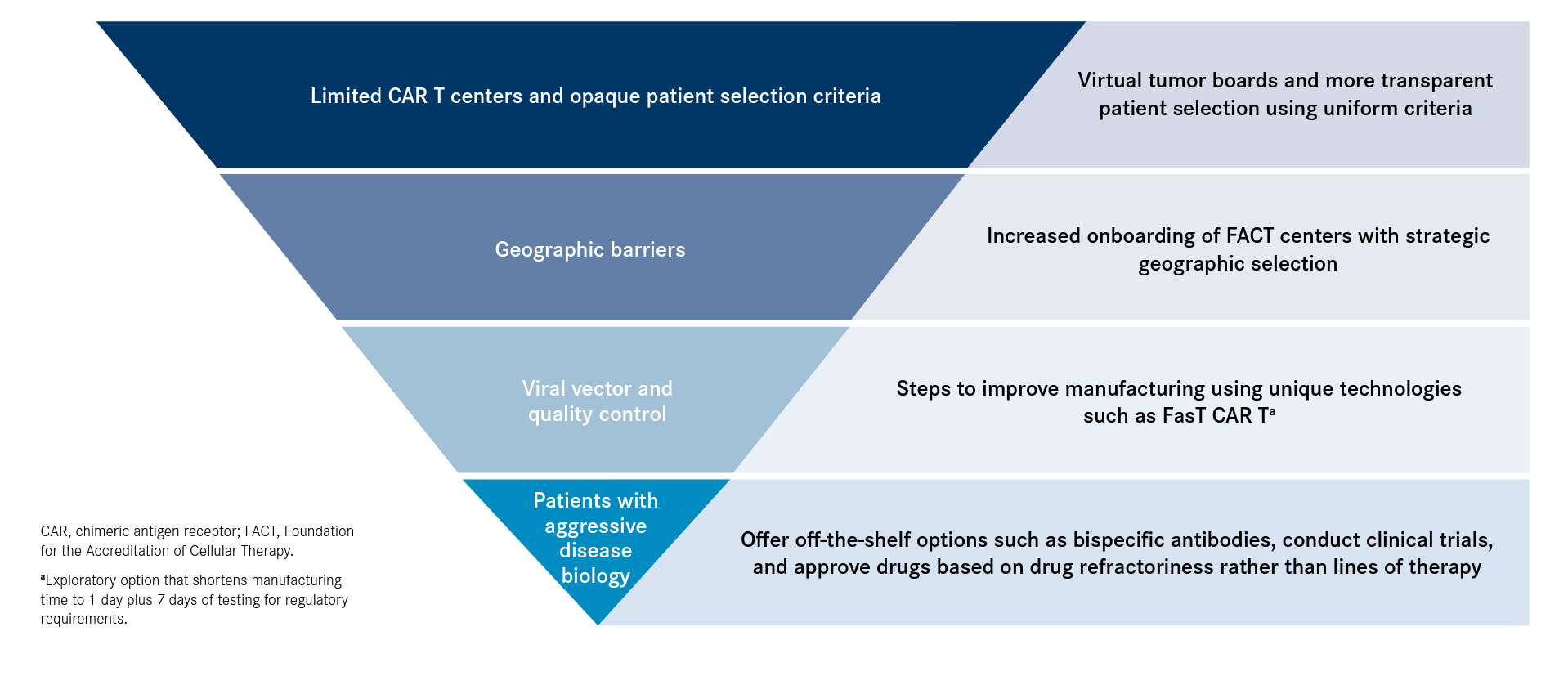
BMS announced that it does not plan to add any more sites to deliver ide-cel in 2023. Similarly, fourth-quarter sales of cilta-cel did not increase in 2022, suggesting that Janssen may be unable to scale up to meet high demand.8 Based on recent studies showing the superiority of CAR T vs standard therapy after 1 to 3 lines of treatment, one of which has been published,9 both BMS and Janssen seem poised to apply for FDA approval for CAR T therapy for patients after 1 to 3 lines of therapy, a much greater population of patients with multiple myeloma. As both companies have recently increased slot allocation without increasing treatment centers, access will remain challenging for underserved communities.
It remains unexplained why the vector/manufacturing issue has been so difficult for the B-cell maturation antigen (BCMA) CAR T treatments compared with the CAR T products used in lymphoma and B-cell lymphoblastic leukemia where patients’ blood can be collected and harvested for T cells within a week of referral to a cancer center. The ability to promptly deliver CAR T for lymphoma and acute lymphoblastic leukemia proves that individualized patient manufacturing is not an insurmountable barrier.
Can Bispecific Antibodies Remedy Issues With BCMA CAR T Therapy?
Teclistamab (Tecvayli) is one of several bispecific BCMA-directed CD3 T-cell engagers, and has recently been approved by the FDA based on the results of the phase 1 MajesTEC-1 (NCT04557098) study that showed an overall response rate of 63%, with nearly all of the responding patients achieving a very good partial response or better.10 Responses were rapid, and as a result, a patient’s disease response trajectory was apparent in 2 months or less. In addition, for patients who responded to therapy, the duration of response (18.4 months) exceeded that reported for ide-cel.11 As teclistamab and other bispecific antibodies are available off the shelf (and therefore on demand) and are associated with much less severe cytokine release syndrome and immune effector cell–associated neurotoxicity syndrome than the CAR T products, these products can be incorporated more easily in community settings and may well replace CAR T because of lack of access for the latter.
Dennis Cooper, MD
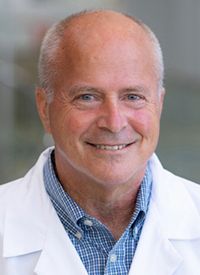
Although there is research that has found patients who progress on 1 T-cell redirecting therapy can respond to a second T-cell redirecting therapy against a different target antigen,11 preliminary evidence suggests that response rates and duration are decreased in patients treated with BCMA CAR T after prior antiBCMA treatment.12
From a theoretical point of view, and analogous to B-cell lymphoma, it would be preferable to sequence a bispecific antibody with a different target than the CAR T and there are several bispecific antibodies against non-BCMA targets moving toward approval.13
At present, patients with rapid disease progression are likely to receive a BCMA bispecific antibody rather than CAR T, possibly jeopardizing their ability to respond to later CAR T treatment.
Strategies to Facilitate Equitable Distribution of CAR T
As in solid organ transplant, where organ allocation is based on need, a similar strategy could be used for distributing CAR T-cell therapy for patients with multiple myeloma. At present, there are more than 200 Foundation for the Accreditation of Cellular Therapy (FACT)approved centers in the United States capable of administering CAR T cells. The restriction of CAR T-cell therapy to select, high-profile centers, some within miles of each other, when other states do not have any is indefensible.
FACT-approved centers should be geographically organized to cover a maximum number of patients with monthly virtual meetings. This way, CAR T products can become available to individuals most in need and who likely have fewer treatment options. Tumor board type allocation of treatment nearer to the patient’s home would certainly be more equitable than awarding treatment slots based on the number of patients entered onto the manufacturer’s protocol, a strategy that lacks transparency and accountability.
In this regard, perhaps the greatest value of high-volume myeloma centers is to offer treatments in clinical trials that cannot be offered in the community, such as non-BCMA bispecific antibodies, non-BCMA CAR T-cell therapies, next-generation cereblon E3 ligase modulators,14 and other new exciting agents such as modakafusp alfa, a fusion protein that targets interferon, the proinflammatory hormone used to treat viral infections and other cancers to cells that have the surface marker, CD38.15 Such strategies could at least temporize worsening disease without jeopardizing the subsequent response to CAR T therapy.
The Time Is Now
CAR T-cell therapy is a hugely important therapeutic option for patients with multiple myeloma, but if this treatment is not accessible, it may as well not exist.
We need to mitigate deadly disparities in cancer care and start by rethinking how designated centers are assigned CAR T products. By establishing a comprehensive and equitable way to obtain and administer CAR T, we can start eliminating pervasive inequities. Without establishing accountability for the pharmaceutical industry and others, access to lifesaving treatments will become even harder. Access to a lifesaving treatment cannot just be a matter of being in the right place at the right time.
Mendel Goldfinger, MD, is a medical oncologist at Montefiore Einstein Cancer Center and assistant professor of medicine at Albert Einstein College of Medicine in the Bronx, New York.
Nishi Shah, MD, is an attending physician at Montefiore Einstein Cancer Center and an assistant professor at Albert Einstein College of Medicine.
Dennis L. Cooper, MD, is chief of Bone Marrow Transplantation at Montefiore Einstein Cancer Center and professor of medicine at Albert Einstein College of Medicine.
References
- Costa LJ, Hungria V, Mohty M, Mateos MV. How I treat triple-class refractory multiple myeloma. Br J Haematol. 2022;198(2):244-256. doi:10.1111/bjh.18185
- Munshi NC, Anderson LD Jr, Shah N, et al. Idecabtagene vicleucel in relapsed and refractory multiple myeloma. N Engl J Med. 2021;384(8):705-716. doi:10.1056/NEJMoa2024850
- Martin T, Usmani SZ, Berdeja JG, et al. Ciltacabtagene autoleucel, an anti-B-cell maturation antigen chimeric antigen receptor T-cell therapy, for relapsed/refractory multiple myeloma: CARTITUDE-12-Year follow-up. J Clin Oncol. 2023;41(6):1265-1274. doi:10.1200/JCO.22.00842
- Voorhees PM, Kaufman JL, Laubach J, et al. Daratumumab, lenalidomide, bortezomib, and dexamethasone for transplant-eligible newly diagnosed multiple myeloma: the GRIFFIN trial. Blood. 2020;136(8):936-945. doi:10.1182/blood.2020005288
- Al Hadidi S, Szabo A, Esselmann J, et al. Clinical outcome of patients with relapsed refractory multiple myeloma listed for BCMA directed commercial CAR-T therapy. Bone Marrow Transplant. Published online December 22, 2022.
doi:10.1038/s41409-022-01905-1 - Kourelis T, Bansal R, Berdeja J, et al. Ethical challenges with multiple myeloma BCMA chimeric antigen receptor T cell slot allocation: a multi-institution experience. Transplant Cell Ther. Published online January 18, 2023. doi:10.1016/j.jtct.2023.01.012
- Alqazaqi R, Schinke C, Thanendrarajan S, et al. Geographic and racial disparities in access to chimeric antigen receptor-T cells and bispecific antibodies trials for multiple myeloma. JAMA Netw Open. 2022;5(8):e2228877. doi:10.1001/jamanetworkopen.2022.28877
- Johnson & Johnson reports Q4 and full-year 2022 results. News release. Johnson & Johnson. January 24, 2023. Accessed March 6, 2023. https://johnsonandjohnson.gcs-web.com/static-files/ca8c3ac2-15ab-4f8d-9693-f604d50be358
- Rodriguez-Otero P, Ailawadhi S, Arnulf B, et al. Ide-cel or standard regimens in relapsed and refractory multiple myeloma. N Engl J Med. Published online February 10, 2023. doi:10.1056/NEJMoa2213614
- Moreau P, Garfall AL, van de Donk NWCJ, et al. Teclistamab in relapsed or refractory multiple myeloma. N Engl J Med. 2022;387(6):495-505. doi:10.1056/NEJMoa2203478
- Mouhieddine TH, Van Oekelen O, Melnekoff DT, et al. Sequencing T-cell redirection therapies leads to deep and durable responses in relapsed/refractory myeloma patients. Blood Adv. Published online August 26, 2022. doi:10.1182/bloodadvances.2022007923
- Suvannasankha A, Mateos MV, Cohen YC, et al. Cilta-cel efficacy and safety in patients with progressive multiple myeloma after exposure to non-cellular anti-BCMA immunotherapy. Transplant Cell Ther. 2023;29(suppl 2):S395-S396.
doi:10.1016/S2666-6367(23)00596-1 - Moreau P, Touzeau C. T-cell-redirecting bispecific antibodies in multiple myeloma: a revolution? Blood. 2022;139(26):3681-3687. doi:10.1182/blood.2021014611
- Watson ER, Novick S, Matyskiela ME, et al. Molecular glue CELMoD compounds are regulators of cereblon conformation. Science. 2022;378(6619):549-553. doi:10.1126/science.add7574
- Vogl DT, Atrash S, Holstein SA, et al. Final results from the first-in-human phase 1/2 study of modakafusp alfa, an immune-targeting attenuated cytokine, in patients (pts) with relapsed/refractory multiple myeloma (RRMM). Blood. 2022;140(suppl 1):1357-1359. doi:10.1182/blood-2022-162253
